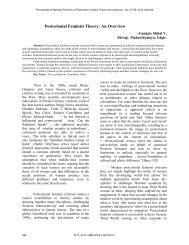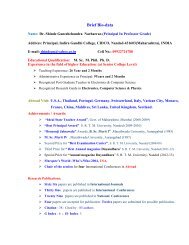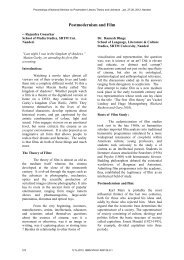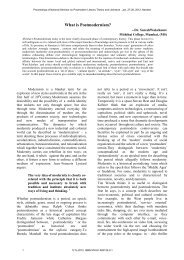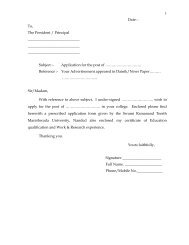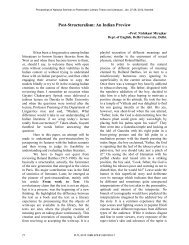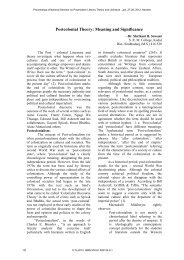Multiculturalism - Igcollege.org
Multiculturalism - Igcollege.org
Multiculturalism - Igcollege.org
You also want an ePaper? Increase the reach of your titles
YUMPU automatically turns print PDFs into web optimized ePapers that Google loves.
Proceedings of National Seminar on Postmodern Literary Theory and Literature , Jan. 27-28, 2012, Nandedinto our understanding of what constitutes ‘crossculturallandscapes.’ The study will help ingrasping the commonalities as well ascontradictions in the two different cultures:Indian and the western. Therefore, the study willconcentrate on the various aspects like traditionand modernity in the works of Ramanujan.As far as Indians are concerned, AcharyaMahapragya and A. P. J. Abdul Kalam haverightly said:Indian people have ingrained beliefsystem and values driven by theircultural norms. In a multi-ethnicsociety, the cultural institutionalstructure embraces kinship,education, religion, property, andeconomy, recreation and certainmodalities. 4Therefore, it seems that it was quite naturalfor Ramanujan to write about his childhoodand the relationships within the family as wellas the Indian society. Indianness in his poemscan be easily felt as his intense feelings figurein his poems most prominently. His poemsare rooted in his Hindu experience. The poetis completely Western in his language,diction and attitude towards the object. Hewas incapable of broad patterns of experiencedespite his talent for language. For himalienation was a means of self-exploration.He was in search for roots. He was justelegant and urbane. His poetry neatly avoidsthe rhetoric, sentimentalism, dogmatism andromanticisation. The ordinary experiences arethe substance for his poems.A.K. Ramanujan played significantrole in creating a cultural space forpostcolonial Indian Writing in English.Through his translations, Ramanujan bringsnational and international variants of realityin a cross-cultural frame. His works are likean enterprise of dialogue and exchangebetween language and cultures. He was bornand brought up in a traditional Indian family.However, he grew up and spent most of hislife in the West. His life in that westernculture provided him a platform where hecould evoke a contrast between his easternbackground and the western culture. Theycome together in such perfect poems as “Stillanother View of Grace”. Any estimate of hispoetry should start from the picture of the“Striders”. The poem properly describes thepoet’s inwardness. The belief or system ofany kind in his poetry comes from bilingualbelief. Such features can be seen till the lastof the poems in “Second Sight”. The veryfirst poem in this collection “Elements ofComposition” brings in the cross-culturalelements like …“and the sweet twisted lives ofepileptic saints, and even as I add, Ialoes, decompose into my elements,into other names and forms, past,and passing, tenses without time,caterpillar on a leaf, eating, beingeaten”. 5A.K. Ramanujan was one of the prominentIndian English writers as far as Indian cultureis concerned. His poetry is largelyautobiographical and reminiscent. Ramanujanhimself says in his essay:“Just as our biological past lives inthe physical body, our social andcultural past lives in the manycultural bodies we inherit - - ourlanguages, arts, religions, and lifecyclerites.” 6His original works are The Striders thatappeared in 1966, Relations (1971), SelectedPoems (1976), Second Sight (1986), andCollected Poems (1995). His translations areThe Interior Landscape: Love Poems from aClassical Tamil Anthology (1967) andSpeaking of Siva, Kannada bhakti poems byVirasaiva saints (1973). His Collected Essaysedited by Vinay Dharwadker was publishedin 1999.A.K. Ramanujan in his ‘Annaiah’sAnthropology’ wrote that one should standapart from one’s own culture to understand itbetter. He wrote:One should come to America forself-knowledge. Like the mahatmawriting his autobiography in prison.Like Nehru discovering his countryafter going to England. You’ve gotto be away from a hill to see it. 7So the word ‘culture’ has acquired differentmeanings in different ages. ‘Culture’ is usedto refer to the social behaviour of the peopleof a society. Cultural negotiation is theadjustment or the balancing of the peoplebetween two different cultures. This is howthe people manage to achieve this balancebetween two cultures. When India became acolony of the West, there began thenegotiation between different cultures. AsIndians were introduced to the Western490 PLTL-2012: ISBN 978-81-920120-0-1



